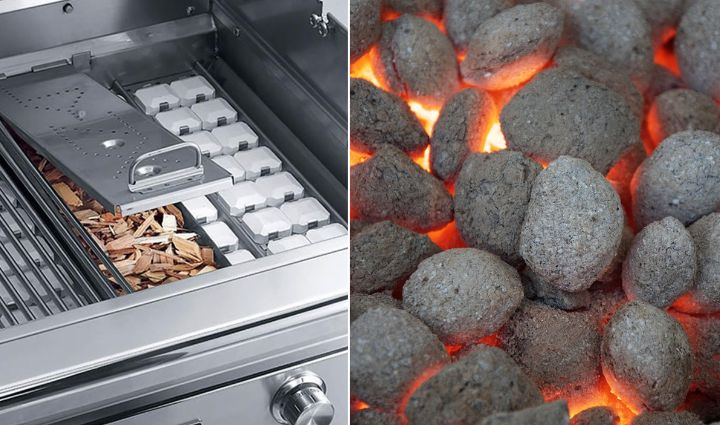Ceramic briquettes can last up to five years and are exclusively used in gas grills to help distribute heat and improve flavor. Charcoal briquettes, on the other hand, last only 1-2 uses and are exclusively used in charcoal grills to generate heat (and provide that classic smokey BBQ flavor).
There’s a ton of information out there comparing ceramic briquettes to lava rocks and heat shields—and this makes total sense since ceramic briquettes are used on a gas grill, just like lava rocks and heat shields.
Ceramic briquettes aren’t as popular as they once were, and many manufacturers have moved away from building grills with ceramic briquettes. But we like to be thorough here at Grill Spot, and because ceramic briquettes are supposed to recreate a more charcoal-like grilling experience on a gas grill, we thought it was about time someone compared ceramic briquettes to charcoal briquettes.
Also, only a few manufacturers produce grills that use ceramic briquettes. There used to be more, but most have moved away from it.
It’s easy to confuse ceramic and charcoal briquettes—they’re both briquettes, after all. But they are not the same thing, and they cannot be used interchangeably. So before we dig into our comparison, let’s take a moment to get to know both types of briquettes, including:
- What are ceramic briquettes?
- What do ceramic briquettes do?
- How long do ceramic briquettes last?
- How to use ceramic briquettes
- What are charcoal briquettes?
- Ceramic briquettes vs. charcoal briquettes comparison
Let’s get grilling!
What are Ceramic Briquettes?
Ceramic briquettes are just that—small pieces of ceramic that are used exclusively in gas grills to help with heat distribution. They are placed in a metal tray above the burners but underneath the cooking grate, and are available in a variety of sizes and shapes. Square, round, rectangular, pyramid-shaped, and flat ceramic briquettes are the most common.
Ceramic briquettes were initially introduced to replace lava rock, which can crumble and create a mess inside the grill. In search of a cleaner alternative, some manufacturers transitioned to ceramic briquettes, while others adopted heat shields for mess-free heat distribution. While ceramic briquettes and heat shields are both helpful for distributing heat, ceramic briquettes are also better at retaining heat than lava rock or heat shields.
What do Ceramic Briquettes do?
Ceramic briquettes are used on gas grills to help distribute heat improve flavor by helping to replicate that delicious charcoal taste. They are the closest replacement to cooking with charcoal without using a charcoal grill.
Ceramic briquettes offer a number of benefits:
- They distribute heat more evenly. On a gas grill, the flame is often distributed along gas pipes, which means there are lines along the cooking surface that are much hotter than the rest of the surface. Ceramic briquettes absorb and reflect this heat towards the cooking grates so the temperature is more even across your grill’s cooking surface.
- They can help improve flavor. What makes charcoal grilling so tasty are the fat drippings that instantly vaporize on the hot coals, creating that delicious smoky flavor. This doesn’t happen as readily with a gas grill, but ceramic briquettes can perform this function similarly to charcoal.
- They retain heat more effectively. Ceramic holds heat, even after your grill has been turned off. This means you’ll use less energy (and fuel) to heat your grill and keep it hot as you cook.
- They can help reduce flare-ups. Any drippings will vaporize the second they hit the briquettes, which means fewer flare-ups (and more delicious flavor). That’s also why you may see ceramic briquettes advertised as “flame tamers.”
How Long Do Ceramic Briquettes Last?
Ceramic briquettes last about 3 years, but with proper care and cleaning, they can easily last up to 5 years.
How to Use Ceramic Briquettes
Ceramic briquettes are placed in a metal tray or rock grate that sits above the grill burners but underneath the cooking grate.
To use ceramic briquettes, you’ll need a grill that’s designed for use with briquettes, a briquette tray, or rock grate.
- Remove the cooking grates.
- Place the briquettes in a single layer in the tray, ensuring they are evenly spaced to allow for proper heat distribution.
- Place the tray on the support ledge.
- Replace your cooking grates and get ready to grill!
GRILL SPOT TIP: Briquettes are just one kind of charcoal you can use in a charcoal grill. Other types of charcoal can be used interchangeably. Compared to ceramic briquettes, these alternatives function similarly to charcoal briquettes but typically contain fewer additives.
Ceramic Briquettes vs. Charcoal Briquettes
They may look the same, but that’s about where the similarities end between charcoal and ceramic briquettes. Charcoal briquettes differ from ceramic in a number of key ways:
- Charcoal briquettes often require lighter fluid, or the briquettes already contain additives that aid in lighting. Ceramic briquettes require neither, making them a cleaner burning alternative. It is possible to light briquettes without lighter fluid using a charcoal chimney or electric starter. Read our guide to learn how.
- Charcoal briquettes are made from sawdust and leftover wood that is burnt down the same way as lump charcoal. However, briquettes include additives that lump charcoal does not, mainly to hold the materials together and to make them easier to light.
- Charcoal briquettes can produce more smoke than ceramic briquettes, which may not work well in some situations like apartment grilling, retirement communities, or even condos.
Compare charcoal and ceramic briquettes in the chart below:
Get Grilling
The choice between ceramic and charcoal briquettes ultimately depends on your grilling preferences and setup.
Ceramic briquettes offer a cleaner, more efficient alternative to gas grills, providing even heat distribution, improved flavor, and reduced flare-ups. They are a practical solution for those who prefer the convenience of a gas grill but still want to capture some of the essence of charcoal grilling.
On the other hand, charcoal briquettes, with their distinct smoky flavor and traditional grilling experience, are ideal for those who enjoy a hands-on process and the robust taste that only charcoal can provide. However, they often require lighter fluid and have potential for more smoke, which might not be preferable for all grillers.
Whether you opt for the modern efficiency of ceramic briquettes and a gas grill or the classic appeal of charcoal grilling, both options promise to amp up your outdoor cooking adventures.




